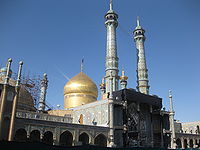- Fātima bint Mūsā
-
Fātimah bint Mūsā' al-Kādhim (Arabic: فاطمة بنت الإمام موسى الكاظم) (commonly known as, Fātimah al-Ma‘sūmah – "Fātimah the Innocent", Fatemah Mæ'sume, Masuma-e-Qum, and "Hadrat Masumah") (1st Dhul Qi‘dah 173 AH – 10th or 12th of Rabī’ al-Thānī 201 AH; approximately March 22, 790 AD – November 7 or 9, 816 AD),[1] was the daughter of the seventh Twelver Shī‘ah Imām, Mūsā' al-Kādhim and sister of the eighth Twelver Shī‘ah Imām, ‘Ali ar-Ridhā.[2] She was looked up to for her piety by all, including Imams.[3]
Contents
From the Ahlul Bayt
Fatima was taught the Islamic sciences by her father and brother. She transcribed hadiths from them. For this reason, she is also known as Aalimah (the Learned Lady) and Muhadditha (the Learned Lady who transmitted hadith). Hadiths quoted by Fatima are considered among the most authentic of all hadiths.[2]
Masumah (The Immaculate)
Due to her faith and training under the Imamate,[4] Fatima was also known as Masumah (the immaculate). She was always busy praying and fasting.[2] She received the status of intercessor because of her worship.[4] She was even revered by her own father and brother, both Imams. Even her gravesite is revered because of millions of miracles that have occurred there. Believers' wishes have been granted and those said to be incurably diseased have been healed.[2]
Her Demise
She died while traveling with some of her brothers to visit her brother in Khurasan. In Saveh, central Iran, they were attacked by the Abbasid army and many of her brothers were killed. Fatima herself was poisoned and became ill. She traveled to the city of Qom and was welcomed by the Imams there. She died on the 10th of Rabi al-Thani in 201.[2]
Burial Rites
Fatima's body was washed and shrouded according to customs. As'ari nobles determined that they would bury her somewhere special, not just an ordinary cemetery. Musa ibn Khazraj had a garden which he donated for her burial place. Qadir was summoned to give her last rites, but instead a stranger appeared and laid her to rest. The town of Qom decided to build her a mausoleum.[5]
Mausoleum of Fatima
The Mausoleum of Fatima was made with straw by the people of Qom. After fifty years, they built the first dome. The whole mausoleum was built by followers of the Ahlul-bayt.[5]
Ziyarah of Fatima
Fatima is now buried in Qom.[2] After she was buried there, so were other children of the Imams. The site gained respect because of this.[5] Traditions from the Imams encourage Shias to perform Ziyarah (pilgrimage) to her grave. Imam Ali-e-Reza said, "Whoever performs the Ziyarah of Fatima will be rewarded heaven."[2] Believers who make a pilgrimage to her shrine say, “O Fatima! Intercede for me in Paradise, because you have a great station near Allah.”[4] Every year, more and more Muslims discover this place and it has brought about an increase of religious scholars in Qom.[5] Her shrine is visited yearly by millions[2] and considered one of the holiest sites in Shi'a Islām.
See also
- Holiest sites in Islam (Shia)
Footnotes
Categories:- Shi'a Muslims
- Muhammad family
- Twelvers
- Iranian Arab people
Wikimedia Foundation. 2010.

